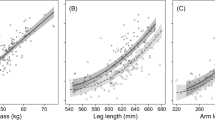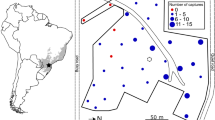Abstract
Data on baboons have generated both the concepts normally associated with male dominance hierarchies among primates and the tests of their significance. The priority-of-access model has been used to predict the relationship between dominance rank and resource acquisition. While the correlation between these two factors, or between rank and measures of reproductive success, has varied among different primate species, most recent baboon field-workers have interpreted their results to be consistent with the model. Based on 1200 hr of observation of a troop of savannah baboons near Gilgil, Kenya, this paper presents data on male agonistic interactions and on male acquisition of resources. Predictions of the priority-of-access model are tested and an inverse relationship is found between agonistic dominance rank and acquisition of two limited resources, estrous females and meat. The importance of the residency status of males is explored and an alternative hypothesis is presented to account for the anomalous pattern in the data. The relationship of male reproductive success and dominance rank is evaluated in light of the data on these baboons and the “residency” hypothesis.
Similar content being viewed by others
References
Alcock, J. (1975).Animal Behavior: An Evolutionary Approach, Sinauer Associates, Sunderland, Mass.
Altmann, J. (1974). Observational study of behavior: Sampling methods.Behavior 49: 22–267.
Altmann, S. A. (1962). A field study of the sociobiology of the rhesus monkey,Macaca mulatto.Ann. N.Y. Acad. Sci. 102: 338–435.
Bernstein, I. S. (1970). Primate status hierarchies. In Rosenblum, L. A. (ed.),Primate Behavior, Vol. 1, Academic Press, New York, pp. 71–111.
Bernstein, I. S. (1976). Dominance, aggression and reproduction in primate societies.J. Theoret. Biol. 60: 459–472.
Blankenship, L. H., and Qvortrup, S. A. (1974). Resource management on a Kenya ranch.Ann. S. Afr. Wildl. Manage. Assoc. 4: 185–190.
DeVore, I. (1965). Male dominance and mating behavior in baboons. In Beach, F. A. (ed.),Sex and Behavior, John Wiley and Sons, New York, pp. 266–289.
Gartlan, J. S. (1968). Structure and function in primate society.Folia Primatol. 8: 89–120.
Hall, K. R. L., and DeVore, I. (1965). Baboon social behavior. In DeVore, I. (ed.).,Primate Behavior, Holt, Rinehart and Winston, New York, pp. 53–110.
Hamilton, W. J. (1978). Sex differences in cooperative behavior of free ranging savannah baboons. Paper presented at Wenner-Gren Conference: Baboon Field Research, Myths and Models, June 1978, New York.
Harding, R. S. O. (1973).Range Utilization by a Troop of Olive Baboons, Unpublished dissertation, University of California, Berkeley.
Hausfater, G. (1975).Dominance and Reproduction in Baboons: Contributions to Primatology, Vol. 7, Karger, Basel.
Hendrickx, A. G., and Kraemer, D. C. (1969). Observation on the menstrual cycle, optimal mating time, and preimplantation embryos of the baboon,Papio anubis andPapio cynocephalus.J. Reprod. Fert. Suppl. 6: 119–128.
Hinde, R. A. (1974).Biological Bases of Human Social Behavior, McGraw-Hill, New York.
Kummer, H., Goetz, W., and Angst, W. (1970). Cross species modifcations of social behavior in baboons. In Napier, J. R. and Napier, P. H. (eds.),Old World Monkeys, Academic Press, New York, pp. 351–364.
Kummer, H., Goetz, W., and Angst, W. (1974). Triadic differentiation: An inhibitory process protecting pair bonds in baboons.Behaviour 49: 62–87.
Landau, H. G. (1951a). On dominance relations and the structure of animal societies. I. Effect of inherent characteristics.Bull. Math. Biophys. 13: 1–19.
Landau, H. G. (1915b). On dominance relations and the structure of animal societies. II. Some effects of possible social factors.Bull. Math. Biophys. 13: 245–262.
Manning, A. (1972).An Introduction to Animal Behavior, 2nd ed., Addison-Wesley, Reading, Mass.
Mayr, E. (1972). Sexual selection and natural selection. In Campbell, B. (ed.),Sexual Selection and the Descent of Man, Aldine, Chicago, pp. 87–104.
Packer, C. (1979). Male dominance and reproductive activity inPapio anubis.Anim. Behav. 27: 37–45.
Parker, G. A. (1974). Assessment strategy and the evolution of fighting behaviour.J. Theor. Biol. 47: 223–243.
Popp, J. (1978).Male Baboons and Evolutionary Principles, Unpublished dissertation, Harvard University, Cambridge, Mass.
Popp, J., and DeVore, I. (1979). Aggressive competition and social dominance theory. In Hamburg, D., and McCown, E. R. (eds.),The Great Apes: Perspectives on Human Evolution, Vol. 5, Holt, Rinehart and Winston, New York, pp. 317–340.
Ransom, T. W. (1971).Ecology and Social Behavior of Baboons (Papio anubis)at Gombe National Park, Unpublished dissertation, University of California, Berkeley.
Ransom, T. W. and Ransom, B. S. (1971). Adult male-infant relations among baboons (Papio anubis).Folia primatol. 16: 179–195.
Rowell, T. E. (1966). Forest living baboons in Uganda.J. Zool. Lond. 147: 344–364.
Rowell, T. E. (1967). Quantitative comparison of the behavior of a wild and a caged baboon group.Anim. Behav. 16: 585–588.
Rowell, T. E. (1972).Social Behavior of Monkeys, Penguin, Kingsport, Tenn.
Rowell, T. E. (1974). The concept of social dominance.Behav. Biol. 11: 131–154.
Saayman, G. S. (1971). behavior of the adult males in a troop of free-ranging chacma baboons (Papio ursinus).Folia primatol. 15: 36–57.
Seyfarth, R. M. (1975).The Social Relationships among Adults in a Troop of Free-Ranging Baboons (Papio cynocephalus ursinus), Unpublished dissertation, Cambridge University, Cambridge, England.
Strum, S. C. (1975). Primate predation: Interim report on the development of a tradition in a troop of olive baboons. Science 187: 755–757.
Strum, S. C. (1976). Primate predation and bioenergetics: A reply.Science 191: 315–317.
Strum, S. C. (1981). Processes and products of change: Baboon predatory behavior at Gilgil, Kenya. In Harding, R. S. O., and Teleki, G. (eds.),Omnivorous Primates: Gathering and Hunting in Human Evolution, Columbia University Press, New York, pp. 255–302.
Wade, T. D. (1977). Status and hierarchy in nonhuman primate societies. In Bateson, P. P. G., and Klopfer, P. (eds.),Perspectives in Ethology, Vol. 3, Plenum Press, New York, pp. 109–134.
Wildt, D. E., Doyle, L. L., Stone, S. C., and Harrison, R. M. (1977). Correlation of perineal swelling with serum ovarian hormone levels, vaginal cytology, and ovarian follicular development during the baboon reproductive cycle.Primates 18: 261–270.
Wilson, E. O. (1975).Sociobiology: The New Synthesis, Harvard University Press, Cambridge, Mass.
Author information
Authors and Affiliations
Rights and permissions
About this article
Cite this article
Strum, S.C. Agonistic dominance in male baboons: An alternative view. Int J Primatol 3, 175–202 (1982). https://doi.org/10.1007/BF02693494
Received:
Revised:
Issue Date:
DOI: https://doi.org/10.1007/BF02693494




